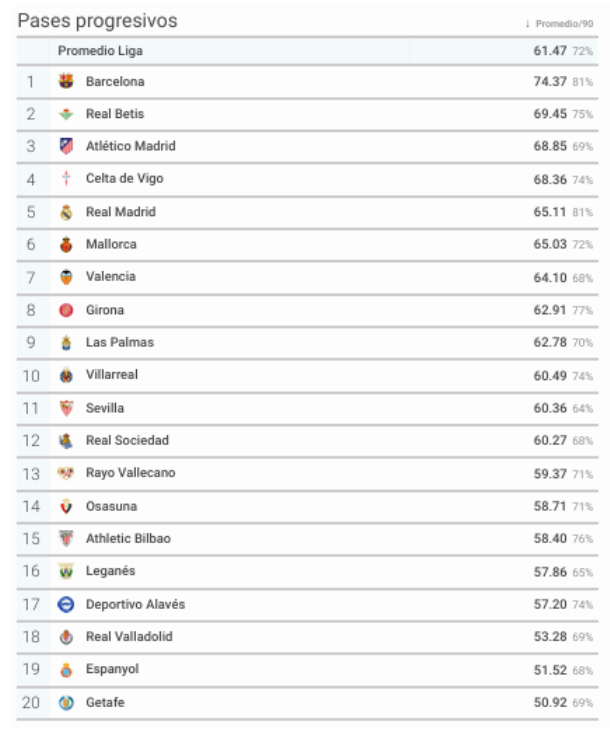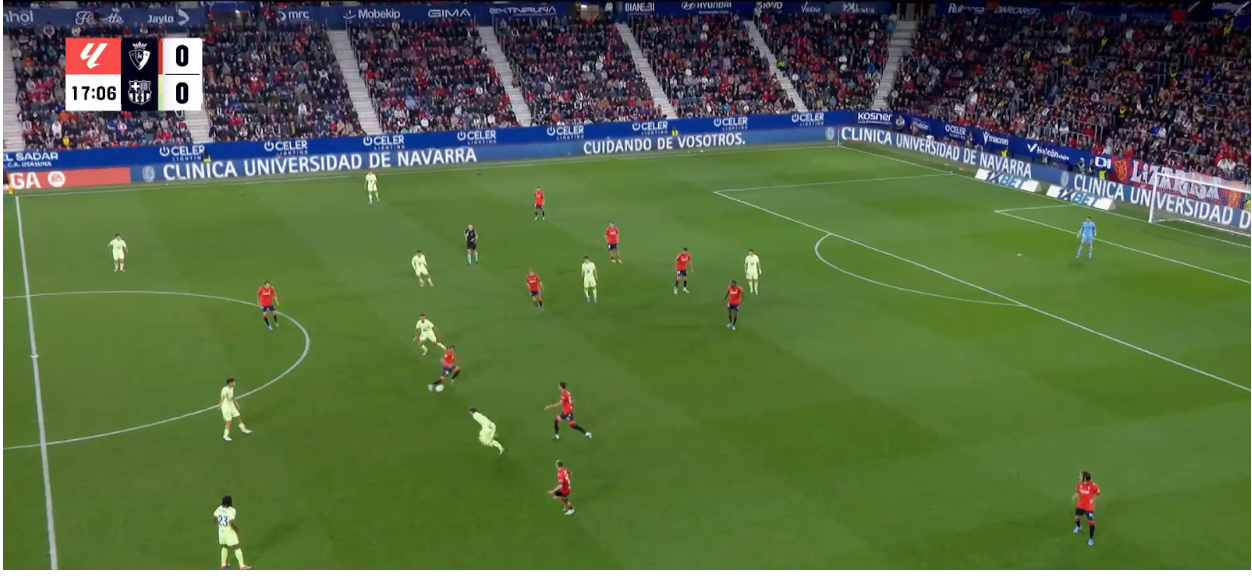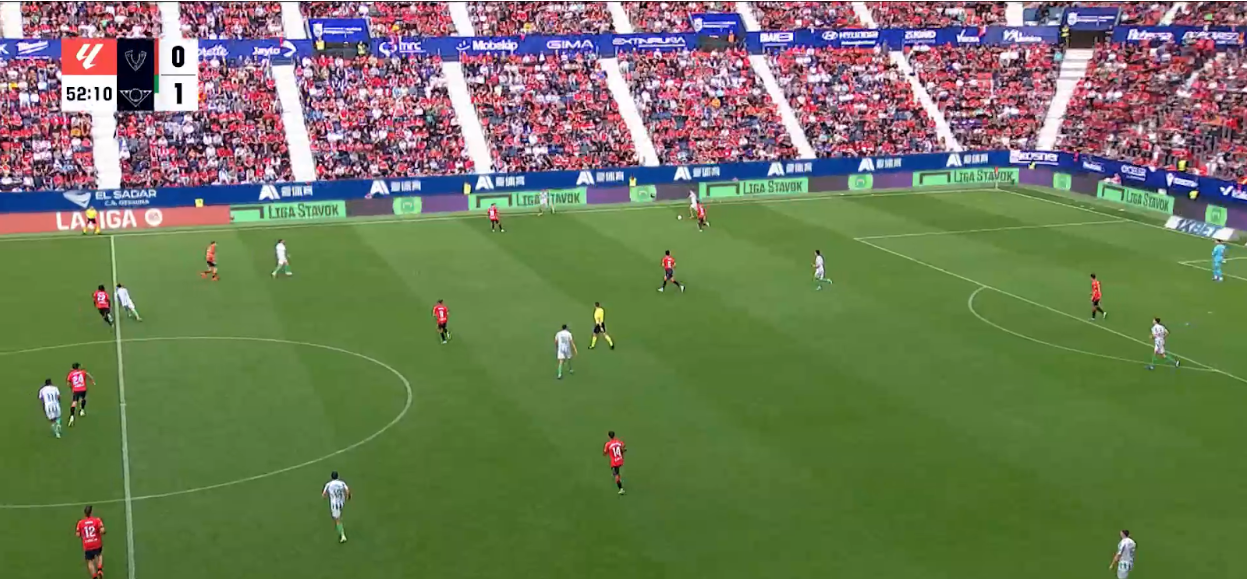Osasuna: Analyzing the Biggest Surprise of the 2024/25 LaLiga Season’s Opening Weeks
After a 2023/24 season that saw them regress from seventh to 11th in the table, Osasuna parted ways with Jagoba Arrasate after a six-year spell. Arrasate left the 2022/23 Copa del Rey finalists for the 2023/24 Copa del Rey finalists in Mallorca, with Osasuna appointing ex-Mallorca manager Vicente Moreno.
It has been nothing short of a dream start to the Moreno era in Pamplona, with Osasuna winning six and drawing three of their first 13 and currently sitting fifth in the table, one point above Real Betis and Real Sociedad, and making a strong push for their first qualification to a European main draw for the first time since 2006/07. Today, we’re taking a look at Osasuna’s red-hot form and whether or not they can keep it up.
Attack
Osasuna usually play in a 4-1-4-1 formation but remain versatile and can change into a 4-2-3-1 or even into a 4-3-3. They usually build up in a 4-2-1-3 with the wingers very wide and the striker making the back line staying further back, therefore, stretching the space in the middle for the midfielders to receive the ball and turn. In addition, at other times, one of the midfielders drops to beat the first line of pressure and the other one stays higher, usually being Aimar Oroz.

However, Osasuna don’t only resort to playing from the back, they also if necessary look to play directly to their center forward, usually Budimir who is excellent in aerial duels. In fact, he is the player with the most aerial duels per 90 with a 40% success rate in these actions.

This and the fact that Osasuna rank poorly in other passing statistics and in possession, show that they are not a possession-based side but rather more direct. For example, they are in 15th placed for passes to the final third, or 14th in progressive passes. Ultimately, this tells us that Osasuna are a team that likes to attack on the counter and recover balls up the field to generate opportunities rather than playing from the back.





In positional play, Osasuna try to form overloads with the full-back Jesús Areso and Rubén García with sometimes Pablo Ibáñez joining in also, with the objective of finding a free player to put a cross into Budimir. However, Pablo Ibáñez is usually seen close to the box as he is very effective arriving in the second line where no one expects him to be.
On the other side, Bryan Zaragoza and Aimar Oroz look to generate opportunities with their undeniable talent with also left-back Abel Bretones joining sometimes. This allows Bryan Zaragoza to get into 1vs1 situations where he is deadly and can create dangerous chances.
Transition to Attack
Osasuna are one of the teams with the least passes in the whole league and this is mainly due to the fact that they are very effective on the counter, using Bryan Zaragoza who stays a bit further up the pitch when defending to then attack on the counter. This was seen very clearly against Barcelona where many times Bryan Zaragoza was able to get into 1vs1 situations against Barcelona’s defenders and there created danger.
In this example, we see that once Osasuna recovered the ball, Aimar’s first option was to move forward which then led to a 1vs1 situation for Bryan Zaragoza where he could cross the ball and Budimir scored off the cross.





In fact, Bryan Zaragoza is the 4th player with the most dribbles per 90 in the league in front of players like Lamine Yamal and Vinícius Júnior. This shows his effectiveness in these sorts of situations and it is something that the manager, Vicente Moreno takes advantage of.

Another factor that characterizes Osasuna’s game is the amount of crosses they play, trying to overload the box with the opposing winger and the two midfielders, especially Pablo Ibánez who is a player who is great at arriving from the second line of attack.
In the image below we can see that there are four Osasuna players in the box ready for a cross or a pass, them being the center forward, the two midfielders and the other winger.

They are the 4th team in the league with the most crosses and the right-back Jesús Areso is the 3rd player with the most crosses in the league which indicates that the full-backs, especially from the right side, move up the pitch. Nonetheless, this is allowed because the usual right-winger Rubén García is left-footed so he usually comes inside for Areso to attack that side.

However, on the other side, the usual left-back Abel Bretones doesn’t move up the field very often due to the fact that Bryan Zaragoza is more comfortable on the wing to participate in his 1vs1 situations.


Moreover, Osasuna very rarely attack through the middle with just 20% of their attacks coming through the center and prefer to attack on the wings which evidences their high amount of crosses. Also, when a ball to Bryan Zaragoza is not possible, they look to play long balls for Ante Budimir to fight and hopefully win the second ball where they then can attack the last defensive line.


Looking at this data, we can also identify that Osasuna are not a team that shoots a lot, however, their xG per shot is higher than most teams at 0.14 which indicates that of a team that crosses the ball frequently. This is because, if a player gets on the end of the cross, it is highly likely that since he is in the box the xG will be relatively high.
Despite not shooting very often they are the 6th team with the most goals scored in the league, above teams like Atlético Madrid and Girona, which shows their efficacy in front of goal.

Defense
Osasuna are a team that like to press high and force turnovers high up the pitch, we can see this in this piece of data which indicates where each team has recovered the most balls. We see that Osasuna recover a high volume of balls in the opposition half and this is mainly due to their pressing system.

Osasuna use a sort of hybrid press in a 4-4-2 shape, this is done by having one of the strikers press the center-back on the ball while the other marks the pivot and if the ball is played to the other center-back they change markers with the other striker pressing the center-back and the original striker coming back to press the pivot. The wingers stick to their full-backs and one midfielder comes to jump on one of the midfielders.
Against Betis in the first half, the press didn’t work very well because the wingers arrived late to the full-backs and in the middle Betis were able to form numerical overloads with Pablo Fornals and Vitor Roque coming close. The numerical advantage and the time that they had on the ball allowed them to generate a few opportunities. In the images below, we can see that they allowed one of the center backs to push forward and with a 2vs1 on the left-back, they were able to find space behind him for one of the strikers.



However, in the second half, the press worked as the players were much more man-oriented and were very aggressive with the center-backs often coming out. In addition, when the Betis center-back would control the ball wide, the strikers would jump to the center-backs while one midfielder of Osasuna jumped on the pivot closest to the ball and the opposing winger came inside to mark the other pivot.
This made Betis find it hard to find any players as Osasuna was more compact and there was less space to move in. In the image below, we can see that Osasuna’s press is far more man-oriented with one of the midfielders pushing up making a 4-4-2 diamond shape and this left Betis without options and ended up kicking the ball up the field and lose the ball.

Against Barcelona, a team that are more possession-based they would usually let the center-backs move up the field so as to reduce their space and then quickly put pressure on them. The objective was to reduce the space in the middle where Barcelona’s most dangerous players are. In addition, Barcelona usually had Alejandro Balde join the attack and so the opposing winger Rubén García would form a back 5 when this occurred so there was no free player.
Meanwhile, Bryan Zaragoza maintained a high position so that when they would recover the ball he was always available in space. Here, we can see that with Pau Cubarsí on the ball, there is little space between the lines, and with the winger coming back to follow the left-back, he has no forward options available.

These pressing and defensive shapes have allowed Osasuna to maintain a solid defensive shape and have also made them a team with a high volume of duels of which Lucas Torró is excellent, being the 5th player with the most recoveries in the league per 90.



In fact, according to the xG, Osasuna should have conceded 3 fewer goals, having conceded 16 goals. This means that in the future they will concede fewer goals and move further up the table.

Conclusion
In conclusion, Vicente Moreno, the Osasuna manager has been able to maximize the strengths of each player which has led to the team succeeding as a whole. In addition, with players like Aimar Oroz and Bryan Zaragoza, Osasuna has two game-defining players on their side. Also, Ante Budimir has proved himself to be an exceptional player in the box, and with the amount of crosses he receives his goal tally will surely increase and be crucial for Osasuna this season.
Furthermore, their pressing and defensive shapes are proving to be successful and one that aids the players to become the best version of themselves, with Lucas Torró having the 5th-most recoveries in the league. Overall, Osasuna has all the pieces necessary to reach European qualification this season if all their players stay fit, and if players like Bryan Zaragoza get injured they may face more difficulties as the season passes.
By: Juan Fernandez Valencia / @ScoutLaLiga
Featured Image: @GabFoligno / Quality Sport Images / Getty Images
